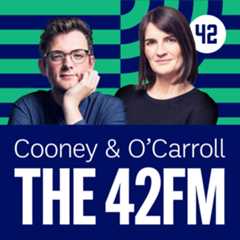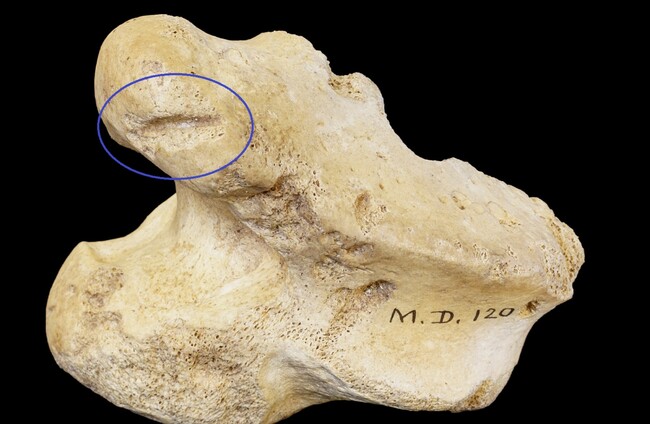A REINDEER BONE fragment uncovered in a cave contains a revelation set to dramatically alter the understanding of Irish human history.
The bone fragment was found at Castlepook Cave near Doneraile in north Cork where a mammoth bone was discovered in 1972.
The bone, a hind leg reindeer femur, establishes human activity in Ireland 33,000 years ago, more than 20,000 years earlier than previously thought.
The cave was excavated by Naturalist Richard Ussher and a team between 1904-1912. Ussher called the cave Mammoth Cave, due to the high volume of woolly mammoth remains discovered there.
The reindeer bone bears chop marks consistent with butchering with a flint or stone tool. However, it was not until the femur fragment was sent for analysis that scientists realised the transformative potential of their discovery.
Radiocarbon dating of the femur revealed it to be 33,000 years old. Up to now the earliest evidence of human activity in Ireland was a butchered bear bone found in a Co Clare cave dated to be 12,500 years old.
The story of the discovery was revealed as part of The Burren: Heart of Stone documentary by Lahinch based filmmaker Katrina Costello, to be broadcast on RTÉ 1 tonight.
In the second installation of her two-part series, Costello met Dr Ruth Carden, one of Ireland’s leading consultant zooarchaeologists. Dr Carden, Adjunct Research Fellow with the School of Archaeology, UCD tells how the discovery of the ancient bone fragment left her astounded.
Carden explained that the bone remains were shipped to the National Museum of Ireland following excavation and were stored in boxes on shelves for more than one hundred years.
In 2008 Dr Carden commenced work on a large personal research project involving antiquarian collections of animal skeletal remains. She set to work examining 60,000 bone fragments that were excavated from at least 11 limestone caves across Ireland in the late 1800s to mid-1900s.
“This bone just changed Irish human history. We have humans coming into Ireland 33,000 years ago, which changes everything for Ireland and changes north Western Europe as a whole,” Dr Carden said.
“We have butchered reindeer bones which have very deep marks, almost like a chopping mark, made by a broad flat tool, a flint tool or a stone tool,” Dr Carden said.
“The radiocarbon dating results came back and I didn’t tell my colleagues for two weeks because I was shocked, to say the least,” she said.
“It is likely the hunter-gatherers would have followed and lived off the migrating reindeer herds to Ireland across wide expanses of lands and water bodies which are now under the sea, in the North-West European region. This research is cutting edge and very exciting as it impacts on how we view humans and animals traversing the lands at that time, and their interactions with each other and past ecosystems,” Dr Carden said.
Until Dr Carden began her thesis, collections of bones had not been fully studied or catalogued.
Her latest discovery arose out of research on the exploitation of reindeer by hunter-gatherers in Ireland, establishing human presence at multiple times during the Upper Palaeolithic period.
Narrated by Brendan Gleeson, ‘The Burren: Heart of Stone’ traces the history of the region through prehistoric times exploring rock formations, early farm settlements and ecology.
Costello’s passion for the area is evident in her portrayal of the raw and complicated beauty of the Burren along with insights from a cast of local contributors.
Her first documentary film, the Silver Branch (2015) told the story of philosopher and fifth-generation farmer Patrick McCormack, owner of Fr Ted’s House outside Corofin, Co Clare. The film earned multiple awards around the world and was nominated for Best Feature Documentary at the Irish Film Awards.
Costello spent five years filming for the Silver Branch, ultimately editing out 90% of her material for the finished product.
For Heart of Stone, Costello spent a further three years immersed in the Burren landscape, this time venturing underground with world-renowned Clare diver and explorer, Jim Warny.
“Beneath the surface of the entire Burren, there is a labyrinth of underground passages, rivers and caves. These are mostly unexplored, but Jim brings us on a journey underground, shedding light on secrets that no human has ever seen.
“The caves are like time capsules of discovery. In ancient times, caves were spiritual places of ritual and sacrifice. Dr Ruth Carden’s discovery changes Irish human history. It just blows North-Western Europe open in terms of human movement,” Costello said.
The Burren: Heart of Stone is available to view on the RTE Player.

